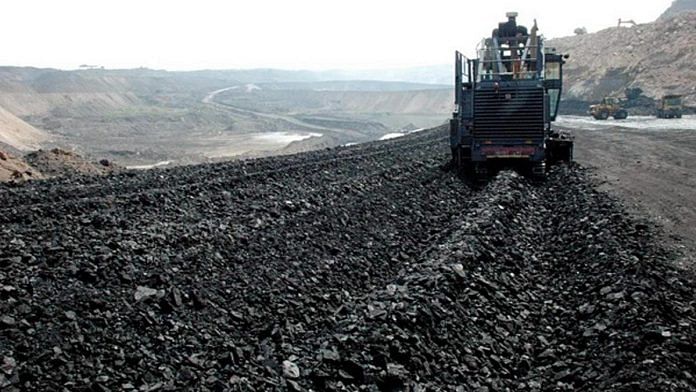New Delhi: Higher coal production, unseasonal rains in April and May, and better coordination between key ministries have meant that thermal power stations across the country have a much better supply of coal this year after last year’s supply crunch.
This should come as good news to industry and households alike because last year saw a severe shortage of coal, with power plants across the country forced to resort to ‘load-shedding’ as their coal stocks dwindled to critical levels.
Coal stocks at a power plant are considered ‘critical’ when the level is less than 25 per cent of what would be needed for 26 days of power production.
By mid-April 2022, coal stocks at power plants had fallen to nine days’ worth of coal, according to a report by the Economic Times.
The picture is different this year. According to market analysis company Crisil, coal stock availability at power plants was 13 days at the end of April 2023, while the number of plants with stocks at critical levels came down to 41 in April this year from 96 last April.
“Proactive efforts by the central government and rains in April have ensured coal availability will be adequate to meet the imminent increase in power demand this summer, amid forecasts of heatwaves,” Crisil said in a research note Monday.
Coal secretary Amrit Lal Meena confirmed this to ThePrint, saying that not only has production increased this year, better coordination between the ministries of coal, power, and railways has also helped.
“We are in a very comfortable position this year as compared to last year, with there being 35 megatonnes (MT) of coal available with thermal power plants and another 65 MT available at the pit-heads of coal mines, ready to be transported,” he said.
Also Read: ‘Pension not revised once since 1998’ — why former coal sector workers are planning fresh stir
Higher production has helped
In its research note, Crisil added that coal production rose 12 per cent year-on-year to a record high of 107.8 MT in March 2023 and 8.63 per cent year-on-year in April 2023. “In contrast, output had fallen 0.2 per cent in March last year, and power demand had surged 14.7 per cent in April,” Crisil said.
As a result, coal stocks at thermal power plants had fallen to an average of eight days by the end of April 2022, it added.
“As many as 96 plants saw their coal buffers declining below the 25 per cent normative requirement (last year),” Crisil said. “This year, the supply situation has fared much better.”
According to an official at the Ministry of Coal who wished not to be named, the production of coal by state-run Coal India — the single largest producer in the country — was 702 MT in the financial year ending 31 March 2023 (FY23), up from 622 MT the previous year.
Further, the production of coal by captive and commercial coal mines also increased to 115 MT from 89 MT over the same period, the official said.
According to a press release by the coal ministry issued on 6 April, coal production in March 2023 increased 12.03 per cent to 107.84 MT from 96.26 MT in March last year. The production by Coal India, Singareni Collieries Company, and captive and commercial mines grew 4.06 per cent, 8.53 per cent and 81.35 per cent, respectively.
Better coordination between ministries
According to Meena, the key reason for the increased availability of coal this year has been better coordination between the main ministries — coal, power, and railways.
“There has been more than adequate planning, keeping in mind the requirement of the power sector,” he said.
A senior Railways official confirmed this to ThePrint, saying that this has helped streamline the coal transport process. The official added that there is a common monitoring system, through which officials at the concerned ministries get access to the same information at any given time, thus simplifying coordination.
While PRAKASH — a web portal for “transparency and better coordination in coal supplies to power plants” — was launched in 2019, it has been used extensively over the past year, the commerce ministry official told ThePrint.
This coordination is critical, especially since its absence earlier was leading to problems in tracking the number of railway rakes that were needed to transport the coal, the quantity of the coal that itself was ready to be transported, and the timing of despatches, among other things.
The official added that the Ministry of Railways has gradually increased the deployment of rakes in order to ensure the smooth supply of coal through the country. Last year, the Railways on an average deployed 421 rakes/day to move coal. This has now increased to an average of 429 rakes/day, ahead of the peak summer season.
“Overall despatch of coal to end users increased 11.6 per cent on-year to 80.35 MT in April 2023,” the Crisil report said. “Despatches made to power plants were up 6.6 per cent to 65.41 MT in the same period.”
Unseasonal rains have helped
The commerce ministry official said the unseasonal rain across parts of India in April and May has helped maintain adequate coal stocks since the actual coal and power demand was lower than had earlier been predicted.
“This allowed the extra stocks to be made available for the peak summer, thereby putting us in a better position,” he added.
This has been confirmed by Crisil, which said that power demand declined 1.1 per cent to 133 billion units (BU) in April as “unseasonal rainfall observed in certain parts of the country further boosted coal stocks compared with April 2022”.
(Edited by Uttara Ramaswamy)
Also Read: More trouble for Adani Group as Bangladesh seeks revision of power deal — ‘excessive pricing’






